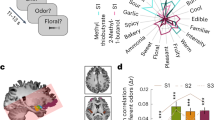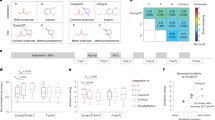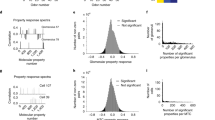Abstract
Organization of receptive surfaces reflects primary axes of perception. In vision, retinal coordinates reflect spatial coordinates. In audition, cochlear coordinates reflect tonal coordinates. However, the rules underlying the organization of the olfactory receptive surface are unknown. To test the hypothesis that organization of the olfactory epithelium reflects olfactory perception, we inserted an electrode into the human olfactory epithelium to directly measure odorant-induced evoked responses. We found that pairwise differences in odorant pleasantness predicted pairwise differences in response magnitude; that is, a location that responded maximally to a pleasant odorant was likely to respond strongly to other pleasant odorants, and a location that responded maximally to an unpleasant odorant was likely to respond strongly to other unpleasant odorants. Moreover, the extent of an individual's perceptual span predicted their span in evoked response. This suggests that, similarly to receptor surfaces for vision and audition, organization of the olfactory receptor surface reflects key axes of perception.
This is a preview of subscription content, access via your institution
Access options
Subscribe to this journal
Receive 12 print issues and online access
$209.00 per year
only $17.42 per issue
Buy this article
- Purchase on Springer Link
- Instant access to full article PDF
Prices may be subject to local taxes which are calculated during checkout






Similar content being viewed by others
References
DeValois, R.L. & DeValois, K.K. Spatial vision. in Encyclopedia of the Human Brain (ed. Ramachandran, V.S.) 419–431 (Academic Press, New York, 2002).
Vater, M. & Kossl, M. Comparative aspects of cochlear functional organization in mammals. Hear. Res. 273, 89–99 (2010).
Fleischer, J., Breer, H. & Strotmann, J. Mammalian olfactory receptors. Front. Cell. Neurosci. 3, 9 (2009).
Iwema, C.L., Fang, H., Kurtz, D.B., Youngentob, S.L. & Schwob, J.E. Odorant receptor expression patterns are restored in lesion-recovered rat olfactory epithelium. J. Neurosci. 24, 356–369 (2004).
Miyamichi, K., Serizawa, S., Kimura, H.M. & Sakano, H. Continuous and overlapping expression domains of odorant receptor genes in the olfactory epithelium determine the dorsal/ventral positioning of glomeruli in the olfactory bulb. J. Neurosci. 25, 3586–3592 (2005).
Moran, D.T., Rowley, J.C. III, Jafek, B.W. & Lovell, M.A. The fine structure of the olfactory mucosa in man. J. Neurocytol. 11, 721–746 (1982).
Gilad, Y., Bustamante, C.D., Lancet, D. & Paabo, S. Natural selection on the olfactory receptor gene family in humans and chimpanzees. Am. J. Hum. Genet. 73, 489–501 (2003).
Kauer, J.S. & Moulton, D.G. Responses of olfactory bulb neurones to odor stimulation of small nasal areas in the salamander. J. Physiol. (Lond.) 243, 717–737 (1974).
Edwards, D.A., Mather, R.A. & Dodd, G.H. Spatial variation in response to odorants on the rat olfactory epithelium. Experientia 44, 208–211 (1988).
Ezeh, P.I., Davis, L.M. & Scott, J.W. Regional distribution of rat electroolfactogram. J. Neurophysiol. 73, 2207–2220 (1995).
Mackay-Sim, A. & Kesteven, S. Topographic patterns of responsiveness to odorants in the rat olfactory epithelium. J. Neurophysiol. 71, 150–160 (1994).
Scott, J.W., Shannon, D.E., Charpentier, J., Davis, L.M. & Kaplan, C. Spatially organized response zones in rat olfactory epithelium. J. Neurophysiol. 77, 1950–1962 (1997).
Leopold, D.A. et al. Anterior distribution of human olfactory epithelium. Laryngoscope 110, 417–421 (2000).
Kent, P.F., Mozell, M.M., Youngentob, S.L. & Yurco, P. Mucosal activity patterns as a basis for olfactory discrimination: comparing behavior and optical recordings. Brain Res. 981, 1–11 (2003).
Mozell, M.M. & Jagodowicz, M. Chromatographic separation of odorants by the nose: retention times measured across in vivo olfactory mucosa. Science 181, 1247–1249 (1973).
Hornung, D.E. & Mozell, M.M. Odorant removal from the frog olfactory mucosa. Brain Res. 128, 158–163 (1977).
Schiffman, S.S. Physicochemical correlates of olfactory quality. Science 185, 112–117 (1974).
Richardson, J.T. & Zucco, G.M. Cognition and olfaction: a review. Psychol. Bull. 105, 352–360 (1989).
Khan, R.M. et al. Predicting odor pleasantness from odorant structure: pleasantness as a reflection of the physical world. J. Neurosci. 27, 10015–10023 (2007).
Zarzo, M. Psychologic dimensions in the perception of everyday odors: pleasantness and edibility. J. Sens. Stud. 23, 354–376 (2008).
Yeshurun, Y. & Sobel, N. An odor is not worth a thousand words: from multidimensional odors to unidimensional odor objects. Annu. Rev. Psychol. 61, 219–241 (2010).
Saito, H., Chi, Q., Zhuang, H., Matsunami, H. & Mainland, J.D. Odor coding by a mammalian receptor repertoire. Sci. Signal. 2, 9 (2009).
Haddad, R. et al. Global features of neural activity in the olfactory system form a parallel code that predicts olfactory behavior and perception. J. Neurosci. 30, 9017–9026 (2010).
Keller, A., Zhuang, H., Chi, Q., Vosshall, L.B. & Matsunami, H. Genetic variation in a human odorant receptor alters odor perception. Nature 449, 468–472 (2007).
Garcia, G.J., Tewksbury, E.W., Wong, B.A. & Kimbell, J.S. Interindividual variability in nasal filtration as a function of nasal cavity geometry. J. Aerosol Med. Pulm. Drug Deliv. 22, 139–155 (2009).
Kobal, G. Elektrophysiologische Untersuchungen des menschlichen Geruchssinns. (Thieme Verlag, Stuttgart, 1981).
Lapid, H. et al. Odorant concentration dependence in electroolfactograms recorded from the human olfactory epithelium. J. Neurophysiol. 102, 2121–2130 (2009).
Mackay-Sim, A. & Kittel, P. Cell dynamics in the adult mouse olfactory epithelium: a quantitative autoradiographic study. J. Neurosci. 11, 979–984 (1991).
Menco, B.P. Qualitative and quantitative freeze-fracture studies on olfactory and nasal respiratory structures of frog, ox, rat and dog. I. A general survey. Cell Tissue Res. 207, 183–209 (1980).
Knecht, M. & Hummel, T. Recording of the human electro-olfactogram. Physiol. Behav. 83, 13–19 (2004).
Hasin-Brumshtein, Y., Lancet, D. & Olender, T. Human olfaction: from genomic variation to phenotypic diversity. Trends Genet. 25, 178–184 (2009).
Keller, A. & Vosshall, L.B. Influence of odorant receptor repertoire on odor perception in humans and fruit flies. Proc. Natl. Acad. Sci. USA 104, 5614 (2007).
Doty, R.L. et al. Intranasal trigeminal stimulation from odorous volatiles: psychometric responses from anosmic and normal humans. Physiol. Behav. 20, 175–185 (1978).
Sakano, H. Neural map formation in the mouse olfactory system. Neuron 67, 530–542 (2010).
Wise, P.M., Zhao, K. & Wysocki, C.J. Dynamics of nasal chemesthesis. Ann. NY Acad. Sci. 1170, 206–214 (2009).
Yang, G.C., Scherer, P.W. & Mozell, M.M. Modeling inspiratory and expiratory steady-state velocity fields in the Sprague-Dawley rat nasal cavity. Chem. Senses 32, 215–223 (2007).
Scott, J.W., Acevedo, H.P., Sherrill, L. & Phan, M. Responses of the rat olfactory epithelium to retronasal air flow. J. Neurophysiol. 97, 1941–1950 (2007).
Haddad, R. et al. A metric for odorant comparison. Nat. Methods 5, 425–429 (2008).
Ayci, F., Aydinli, M., Bozdemir, Ö.A. & Tutaş, M. Gas chromatographic investigation of rose concrete, absolute and solid residue. Flavour Fragrance J. 20, 481–486 (2005).
Purves, D., Beau Lotto, R., Mark Williams, S., Nundy, S. & Yang, Z. Why we see things the way we do: evidence for a wholly empirical strategy of vision. Phil. Trans. R. Soc. Lond. B 356, 285 (2001).
Howe, C.Q. & Purves, D. The Müller-Lyer illusion explained by the statistics of image-source relationships. Proc. Natl. Acad. Sci. USA 102, 1234 (2005).
Wesson, D.W. & Wilson, D.A. Sniffing out the contributions of the olfactory tubercle to the sense of smell: hedonics, sensory integration, and more? Neurosci. Biobehav. Rev. 35, 655–668 (2011).
Li, W. et al. Right orbitofrontal cortex mediates conscious olfactory perception. Psychol. Sci. 21, 1454–1463 (2010).
Gottfried, J.A. & Dolan, R.J. The nose smells what the eye sees: crossmodal visual facilitation of human olfactory perception. Neuron 39, 375–386 (2003).
Gottfried, J.A., Winston, J.S. & Dolan, R.J. Dissociable codes of odor quality and odorant structure in human piriform cortex. Neuron 49, 467–479 (2006).
Moran, D.T. Anatomy and ultrastructure of the human olfactory neuroepithelium. in Handbook of Olfaction and Gustation (ed. Doty, R.L.) 75–102 (Marcel-Dekker, New York, 1995).
Maresh, A., Rodriguez Gil, D., Whitman, M.C. & Greer, C.A. Principles of glomerular organization in the human olfactory bulb—implications for odor processing. PLoS ONE 3, e2640 (2008).
Kepecs, A., Uchida, N. & Mainen, Z.F. The sniff as a unit of olfactory processing. Chem. Senses 31, 167–179 (2006).
Mainland, J. & Sobel, N. The sniff is part of the olfactory percept. Chem. Senses 31, 181–196 (2006).
Hummel, T., Futschik, T., Frasnelli, J. & Huttenbrink, K.B. Effects of olfactory function, age, and gender on trigeminally mediated sensations: a study based on the lateralization of chemosensory stimuli. Toxicol. Lett. 140–141, 273–280 (2003).
Acknowledgements
This work was supported by ERC-FP7 Ideas grant #200850 and by the James S. McDonnell Foundation.
Author information
Authors and Affiliations
Contributions
H.L. and N.S. conceived the study. H.L., S.S., A.P., T.H., Y.R. and N.S. designed the experiments. H.L., S.S. and A.P. performed the experiments. H.L., E.S., H.V. and N.S. analyzed the data. H.L., T.H., E.S. and N.S. wrote the manuscript.
Corresponding authors
Ethics declarations
Competing interests
The authors declare no competing financial interests.
Supplementary information
Supplementary Text and Figures
Supplementary Figures 1 and 2, and Supplementary Tables 1–3 (PDF 202 kb)
Rights and permissions
About this article
Cite this article
Lapid, H., Shushan, S., Plotkin, A. et al. Neural activity at the human olfactory epithelium reflects olfactory perception. Nat Neurosci 14, 1455–1461 (2011). https://doi.org/10.1038/nn.2926
Received:
Accepted:
Published:
Issue Date:
DOI: https://doi.org/10.1038/nn.2926
This article is cited by
-
High-precision mapping reveals the structure of odor coding in the human brain
Nature Neuroscience (2023)
-
Physicochemical features partially explain olfactory crossmodal correspondences
Scientific Reports (2023)
-
Representationalism and Olfactory Valence
Review of Philosophy and Psychology (2023)
-
Incidence of Anosmia among Covid 19 patients in India
Indian Journal of Otolaryngology and Head & Neck Surgery (2022)
-
Assessment of the difference in detection of pleasant and unpleasant odors in different grades of hyposmia
The Egyptian Journal of Otolaryngology (2021)



